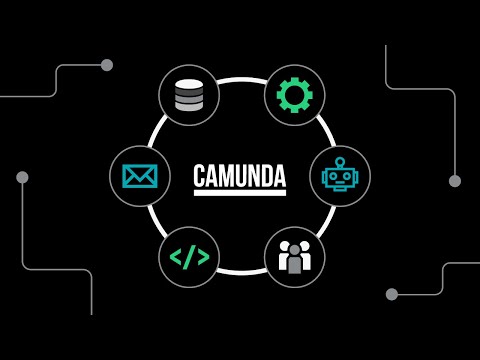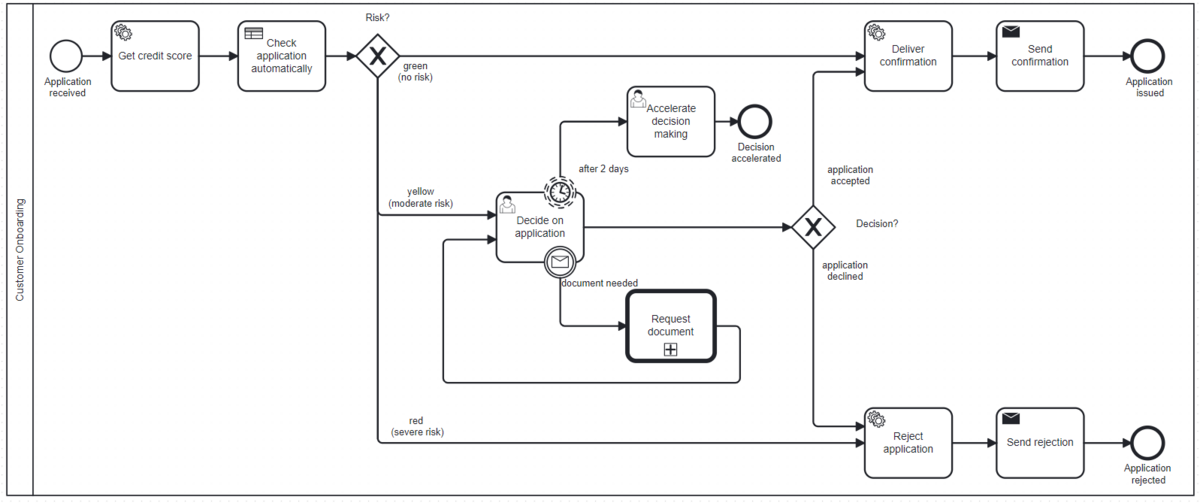Automation is an important topic for businesses across a range of industries today, and chances are you’re encountering automated business processes regularly in your daily life. Whether it’s as simple as an auto-reply to your email or as complex as approval for a bank loan, processes that used to take days or weeks can now happen much faster as a result of automation.
Automation maturity can be a strong differentiator for companies that get it right, but automation alone only gets you so far. Process orchestration is critical to achieving a high level of maturity in complex environments, but the term is often confused with process automation. So what is the difference between automation and orchestration?
Let’s compare automation vs orchestration to understand the value each can bring to your organization.
What is automation?
Automation allows you to run a specific task or process with the least possible human involvement. Automating a process means that automation software is running that process for you based on logic you have defined.
Essentially, it uses technology to take a task that was once manual and accomplish it as “automatically” as possible.
Process automation vs workflow automation
Process automation and workflow automation are often used interchangeably, but there are subtle differences. Workflow automation typically often refers to the automation of shorter and simpler tasks that can be completed without human involvement. Process automation usually refers to a longer, potentially end-to-end task that can span multiple devices, systems, people, and even departments.
Goals of automation
The goal of automation is to increase the efficiency of a process, reducing the time, money and effort spent completing it manually. It takes a task that may be time-consuming or repetitive and lets you automate it quickly, reliably, and as often as necessary.
Example of process automation
There are many potential uses of process automation—just about everyone faces manual tasks they probably wish they could automate. For example, let’s say you’re bringing in a new customer at a bank, who wants a loan. You might want to create an automation that starts a little like this to simplify the application:

This model shows that when a new application is submitted, the credit score should be retrieved, and the application checked against it automatically.
What is orchestration?
Orchestration involves coordinating the many endpoints of business processes. Orchestrating your processes means connecting complex automations together that can traverse many different teams or stakeholders and integrate with numerous systems and devices—all without losing visibility into the end-to-end process.
Process orchestration vs workflow orchestration
While both involve orchestrating multiple tasks, process orchestration and workflow orchestration are not the same. As stated above, workflows tend to be relatively short and fully automated, whereas processes can be more complex and interact with many users and systems. Workflow orchestration therefore tends to be more limited in scope than process orchestration.
Goals of orchestration
The goal of orchestration is to increase the effectiveness of your processes, particularly long-running or complex ones, making them more efficient and providing visibility from start to finish. Orchestration unifies multiple automated tasks or processes so they can be easily understood and optimized.
So what’s really the difference between orchestration and automation?
One way to understand the difference is to look at a simple local automation, such as an RPA bot. These bots perform a single task automatically, and can make a formerly manual process much faster. However, once you want to automate more than a handful of tasks, it can get hard to keep a handle on all the RPA bots you have running—a problem that only increases at high scale.
Orchestration can help you manage your RPA bots so that you understand what each one is doing at all times, giving you visibility into bottlenecks and areas of improvement. It also makes it easier to connect them to other relevant processes in your business, removing redundancies and simplifying maintenance and management.
In other words, while simple automations can often stand by themselves, once your automation maturity reaches a certain level of complexity, orchestration is necessary to keep your automation environment healthy and efficient as it grows.
Example of Process Orchestration
Process orchestration is ideal when you need to manage complex processes with multiple endpoints. Let’s return to our banking example, but now after checking the application, you want to decide whether to approve it for a loan or not.
Sometimes the decision will be easy to automate based on preset rules, but this isn’t something you can simply automate completely. Creditworthiness is a complex determination, and making the wrong decision on loan applications can mean a bank going out of business. For a mission-critical process like this, you will want a human expert to be involved in cases where there is uncertainty.
To manage all the possible cases, you might utilize process orchestration to build a model like this:
Now when an application is received, a risk evaluation is made. If the risk is considered low or high—that is, if the answer is reasonably obvious—you can proceed right to acceptance or rejection, complete with automated messages sent via email.
However, if the risk is somewhere in between, the task is given to a human to evaluate. To make the process more efficient, if an application is sitting in a queue for more than two days, it is automatically accelerated. If more information is needed, additional documents can be requested from the applicant, and they automatically re-enter the queue.
As you can see, there are a lot of different automations involved here, but process orchestration (along with a standard way of visualizing processes, like BPMN) allows you to tie them all together and manage the entire complex process from end-to-end. By visualizing the entire process it would be easy to see where the bottlenecks are, and then iterate by doing things like changing the DMN table that evaluates risk, or adjusting the timer for acceleration, all from one place.
With process orchestration, additional features could also be implemented to address pain points as they arise, such as customers beginning an application on one device and completing it on another, or allowing tasks to be processed in parallel.
Common use cases of process orchestration
Process orchestration is useful whenever you need to automate a task that involves multiple steps, stakeholders or systems. Most complex processes can benefit from orchestration. Some examples of process orchestration in action include:
- Atlassian, a leading technology company, is using process orchestration within their hyperautomation tech stack to improve customer and employee experiences.
- Kiwi.com, an organization that helps travelers find ideal travel routes and prices, used process orchestration to improve their customer booking journey.
- The U.S. Department of Veterans Affairs, which helps U.S. veterans access benefits, transformed how they process benefit claims with process orchestration.
There are many industries, such as financial services and insurance, that face strict regulations and utilize complex processes which must run at high speeds and with perfect accuracy. Process orchestration is ideal for these kinds of essential processes.
Process automation vs process orchestration: What’s better?
We think a lot about questions like this at Camunda, where our goal is to help you solve even your most complex automations. When it comes to orchestration vs automation, the answer is that one isn’t better than the other. Process automation is very useful, and process orchestration couldn’t exist without it.
In some cases, process automation by itself will be fine for solving relatively simple issues. But at a certain point, as your processes become more complex and you want to automate more critical tasks, you need more than simple automation tools. Process orchestration enables process automation at the highest level.
Process orchestration allows you to facilitate things like human task orchestration, microservices orchestration and more across multiple systems or devices, and also gives you the end-to-end visibility that will allow you to understand and optimize a process over time. When a highly complicated process has to be both reliable and fast, as well as easy to understand, improve and fix, process orchestration is required.
Learn more about process orchestration at Camunda
Camunda Platform 8 has been designed to make it easy to get started modeling and automating your processes quickly. Learn more about how Camunda can help in the video below, or sign up for a free trial today to test it out yourself.

Read More
Want to learn more about process orchestration or automation? Check out the links below to keep learning.
- Process Orchestration [Guide]
- 2023 State of Process Orchestration [Report]
- Orchestration vs Choreography [Blog]
- Process Automation Center of Excellence [Handbook]
- Benefits of Microservices [Blog]
- Cost Savings with Process Orchestration [Guide]
- Prioritizing Our DevRel Backlog with Form Builder, DMN, and a Process Model [Blog]


